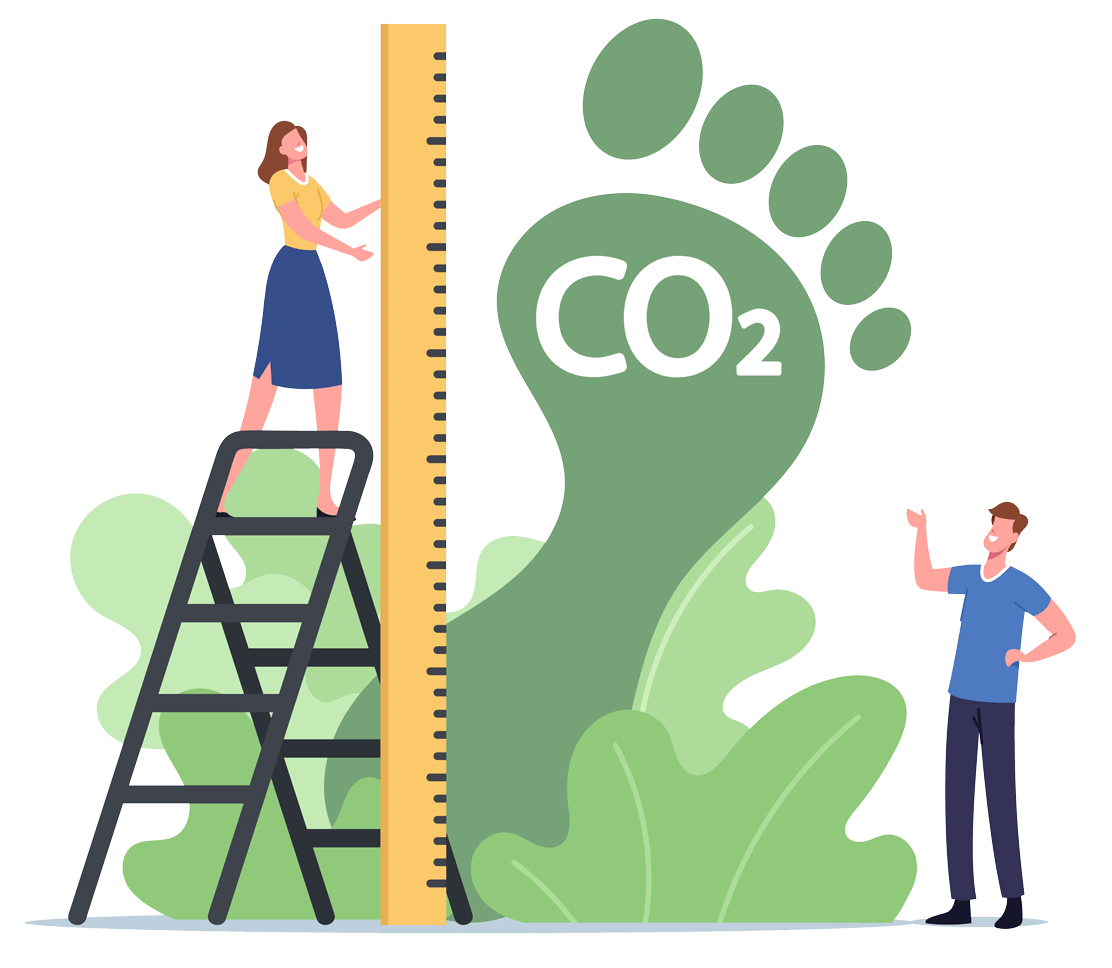
Carbon footprint units of measurement

We all talk about reducing our carbon footprint, but do we really know how to measure it?
Without knowing the proper units, we can’t raise awareness or do anything about it, which makes it difficult to take effective action.
By the end of this article, you will not only know the units, but you will also be able to interpret them and use them to your advantage.
What will the reader learn from this article about units of measurement for the carbon footprint?
- The reader will learn about different units of measurement for carbon footprints.
- They will understand the concept of carbon dioxide equivalents (CO2e) and how it accounts for different greenhouse gasses.
They will gain knowledge about units such as:
- Carbon dioxide equivalents
- Kilograms or metric tons
- Pounds
- Energy units
- Passenger-miles
- Passenger-kilometers
- Square footage or
- Square meters
- Carbon intensity per dollar of GDP
- Carbon intensity per unit of production
- Carbon intensity per capita
- Carbon intensity per product or service
- Carbon intensity per activity or behavior
What are the different units of measurement for carbon footprints?
Understanding the various units of measurement for carbon footprints is crucial for addressing the environmental impact of various activities.
As individuals, organizations, and governments strive to reduce their carbon emissions and minimize their contribution to global warming, measuring carbon footprints provides valuable insights into the environmental impact of different actions and choices.
Carbon Dioxide Equivalents (CO2e)
One of the most commonly used units of measurement for carbon footprints is carbon dioxide equivalents (CO2e).
CO2e is a standard unit that allows for the comparison of different greenhouse gasses based on their global warming potential (GWP).
By quantifying the amount of greenhouse gas emissions produced by an individual, organization, or product, carbon footprint analysis provides valuable insights into the environmental impact of various activities.
CO2e provides a comprehensive measurement of emissions by considering not only carbon dioxide (CO2), but also other greenhouse gasses such as:
- Ethane (CH4)
- Nitrous oxide (N2O).
These gasses have significantly higher warming potentials than CO2, and their inclusion in the calculation of carbon footprints gives a more accurate representation of the overall environmental impact.
According to a source, the standard unit of measurement for carbon footprints is grams of carbon dioxide equivalents (CO2e). The more weight in carbon dioxide you emit, the greater the environmental impact.
Kilograms (kg) or Metric Tons (t)
Kilograms and metric tons are commonly used units for quantifying total emissions. These units are particularly useful when assessing the carbon footprints of individuals, organizations, and products.
The use of kilograms or metric tons allows for a more tangible understanding of the scale of emissions.
When measuring carbon footprints, kilograms and metric tons are often used to express the total amount of greenhouse gas emissions over a specific time period.
This can be a yearly, monthly, or even a daily measurement, depending on the context.
By using these units, the environmental impact of an activity or entity can be easily comprehended and compared.
For example, an individual’s carbon footprint may be measured in kilograms or metric tons of CO2e emitted per year.
Similarly, organizations may report their emissions in metric tons of CO2e produced annually. This unit of measurement provides a clear understanding of the magnitude of emissions and allows for effective comparison and analysis.
Pounds (lbs)
In certain regions, pounds are used as a unit of measurement for carbon footprints. This unit is particularly familiar to audiences in the United States, where the imperial system is still commonly used.
Utilizing pounds as a unit of measurement allows for better comprehension and relatability for individuals in these regions.
By expressing carbon footprints in pounds, individuals and organizations can better understand their emissions in the context of familiar metrics.
This facilitates the understanding of the environmental impact and encourages more effective engagement in emission reduction efforts.
Energy Units (kWh or MWh)
Linking carbon footprints to energy consumption provides valuable insights into the environmental impact of energy usage.
Energy units such as:
- Kilowatt-hours (kWh)
- Megawatt-hours (MWh)
Are used to measure emissions based on the energy consumed.
When calculating carbon footprints, energy consumption is considered, and emissions are quantified based on the amount of energy consumed.
This unit of measurement provides a direct correlation between energy usage and carbon emissions, helping individuals and organizations identify opportunities for energy efficiency and emission reduction.
It is important to note that the carbon intensity of energy sources plays a crucial role in determining the carbon footprint associated with energy consumption.
For example, energy derived from fossil fuels such as coal or oil has a higher carbon intensity compared to renewable energy sources like solar or wind power.
By considering the carbon intensity of energy sources, a more accurate measurement of carbon footprints can be achieved.
Passenger-miles or Passenger-kilometers
Transportation is a significant contributor to carbon emissions, and measuring the carbon footprints of different modes of transportation is crucial in understanding their environmental impact.
Passenger-miles or passenger-kilometers are units that quantify emissions per person per distance traveled.
To calculate the carbon footprint of transportation, emissions are measured based on the distance traveled by each passenger.
This unit of measurement allows for comparisons between different modes of transportation and enables individuals and policymakers to make informed decisions regarding their travel choices.
For example, air travel is known to have a higher carbon footprint compared to other modes of transportation.
According to a source, the idea is to express the impact of each different greenhouse gas in terms of the amount of CO2 that would create the same amount of warming.
Square Footage or Square Meters
Buildings and housing contribute significantly to carbon emissions, primarily through:
- Energy consumption for heating
- Cooling
- Operation
Measuring carbon footprints in terms of square footage or square meters provides insights into the environmental impact of buildings.
When assessing the carbon footprints of buildings, emissions are calculated based on the area of the building.
This unit of measurement takes into account the energy consumption associated with the operation of the building and allows for comparisons between different structures.
By quantifying emissions per unit of area, individuals and organizations can identify areas for improvement in energy efficiency and implement measures to reduce their carbon footprints.
Carbon Intensity per Dollar of GDP
Measuring carbon footprints in the context of countries or economies provides valuable insights into the environmental impact of economic activities.
Carbon intensity per dollar of GDP is a unit that evaluates emissions related to economic output.
By quantifying emissions per unit of economic output, policymakers and researchers can:
- Track progress
- Identify areas for improvement
- Develop effective policies to reduce carbon footprints.
This unit of measurement allows for the comparison of emissions between different countries or regions, taking into account economic disparities.
Carbon Intensity per Unit of Production
In industrial settings, measuring carbon footprints per unit of production is crucial for identifying opportunities for emission reduction.
This unit of measurement allows for the evaluation of emissions associated with manufacturing processes and the production of goods.
By quantifying emissions per unit of production, industries can identify areas where emissions can be reduced, such as:
- Optimizing production processes
- Implementing energy-efficient technologies
- Using alternative materials.
This unit facilitates the identification of emission hotspots and the implementation of targeted measures to reduce carbon footprints.
Carbon Intensity per Capita
Comparing carbon footprints between countries or regions provides insights into variations in emissions based on population and lifestyle factors.Carbon intensity per capita is a unit that calculates average emissions per person.
This unit of measurement allows for a comparison of emissions between countries with different population sizes.
It takes into account variations in lifestyle, energy consumption, and economic activities.
By understanding the differences in per capita footprints, policymakers can develop strategies to promote sustainable practices and reduce overall emissions.
Carbon Intensity per Product or Service
Analyzing the carbon footprints of specific products or services provides valuable information about their environmental impact.
Carbon intensity per product or service is a unit that evaluates emissions throughout the lifecycle of a product.
This unit of measurement takes into account emissions associated with the production, transportation, and disposal of a product or service.
It provides insights into the carbon footprint of different goods and services and allows for informed consumer choices.
By considering the carbon intensity per product or service, individuals and organizations can opt for more sustainable alternatives and contribute to emission reduction efforts.
Carbon Intensity per Activity or Behavior
Measuring emissions associated with specific activities or behaviors provides valuable insights into individual contributions to carbon footprints.
Carbon intensity per activity or behavior is a unit that calculates:
- Emissions for everyday actions
- The diet
- Transportation choices.
This unit of measurement allows individuals to understand the environmental impact of their daily activities and make informed decisions to reduce their carbon footprints.
By quantifying emissions per activity or behavior, individuals can identify areas for improvement and adopt more sustainable practices.
Conclusion
In conclusion, understanding the various units of measurement for carbon footprints is crucial for addressing the environmental impact of various activities.
By utilizing different units of measurement, such as:
- Carbon dioxide equivalents
- Kilograms or metric tons
- Pounds,
- Energy units
- Passenger-miles
- Passenger-kilometers
- Square footage or
- Square meters
- Carbon intensity per dollar of GDP
- Carbon intensity per unit of production
- Carbon intensity per capita
- Carbon intensity per product or service
- Carbon intensity per activity or behavior
All of the above can be achieved by comprehensive assessment of emissions.
Choosing the appropriate unit of measurement depends on the context and purpose of the analysis. Each unit provides unique insights into different aspects of carbon footprints and allows for effective comparison and analysis.
By understanding the various units of measurement and their applications, individuals, organizations, and policymakers can make informed decisions and contribute to global efforts to address climate change and promote sustainability.
Remember, for more detailed information, you can refer to the following sources:
– Carbon Footprint Analysis
– Shrink That Footprint – What Is A Carbon Footprint?
Unit of Measurement | Description | Application |
Carbon Dioxide Equivalents (CO2e) | Standard unit that allows for the comparison of different greenhouse gasses based on their global warming potential (GWP) | Provides a comprehensive measurement of emissions by considering multiple greenhouse gasses |
Kilograms (kg) or Metric Tons (t) | Measures the total amount of greenhouse gas emissions over a specific time period | Useful for quantifying individual, organizational, and product carbon footprints |
Pounds (lbs) | Familiar unit of measurement in regions where the imperial system is used | Provides better comprehension and relatability for individuals in those regions |
Energy Units (kWh or MWh) | Measures emissions based on the energy consumed | Correlates energy usage with carbon emissions, allowing for identification of energy efficiency opportunities |
Passenger-miles or Passenger-kilometers | Quantifies emissions per person per distance traveled | Facilitates comparison of carbon footprints between different modes of transportation |
Square Footage or Square Meters | Measures emissions based on the area of a building | Provides insights into the environmental impact of buildings and allows for comparisons between different structures |
Carbon Intensity per Dollar of GDP | Evaluates emissions related to economic output | Enables comparison of emissions between countries or regions, accounting for economic disparities |
Carbon Intensity per Unit of Production | Evaluates emissions associated with manufacturing processes and production of goods | Identifies opportunities for emission reduction in industrial settings |
Carbon Intensity per Capita | Calculates average emissions per person | Allows for comparison of emissions between countries with different population sizes and lifestyle factors |
Carbon Intensity per Product or Service | Evaluates emissions throughout the lifecycle of a product or service | Provides information for informed consumer choices and promotes sustainable alternatives |
Carbon Intensity per Activity or Behavior | Calculates emissions for specific activities or behaviors | Enables individuals to understand their contributions to carbon footprints and adopt more sustainable practices |
What causes carbon footprint? From everyday activities to industrial impacts, learn how to mitigate your environmental footprint effectively."
Understand carbon footprint units like CO2e and kilograms to measure and reduce your environmental impact effectively.
Explore the different carbon footprint types—direct, indirect, embodied, and product—and learn strategies to reduce your environmental impact effectively.
Learn how to reduce your personal carbon footprint with practical strategies on energy, transportation, diet, and waste. Make a sustainable impact today.
Discover practical tips on reducing your water carbon footprint. Learn about water-saving strategies and their impact on climate change in this enlightening guide.
Offset your carbon footprint effectively with expert guidance. Understand the impact of your daily activities on emissions, calculate your footprint accurately, and support reputable offset projects.
Learn practical ways to reduce your carbon footprint & fight climate change. From energy conservation to sustainable transportation & eco-friendly diets, take steps for a greener future!
The secrets of reducing your carbon footprint in products. Learn the importance, calculation methods, and actionable strategies for a sustainable future. Dive in now!
Sustainable strategies to shrink your carbon footprint. Learn eco-friendly practices for a greener lifestyle. Act now for a better world!
Ecuador's Zero Carbon Programme is a testament to the country's commitment to sustainability, setting a global example. This guide highlights the program's strategies, benefits, and how businesses can align with these green initiatives.
Discover the importance of Carbon Reporting in our analysis of Carbon accounting. Learn how to communicate your sustainability efforts clearly and transparently. Read more
Global Net Zero Programs leading the charge towards sustainability. From Latin America's innovative policies to the EU's Green Deal, this guide illuminates the path to a greener future for businesses, policymakers, and individuals.










